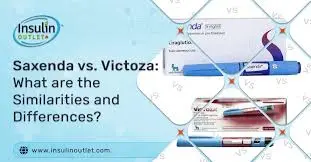Victoza and Saxenda, In the realm of diabetes management and weight loss solutions, Victoza and Saxenda are two prominent medications that often come up in discussions. Both products contain the same active ingredient, liraglutide, but they are designed for different purposes. This blog post will explore the similarities and differences between Victoza and Saxenda, their mechanisms of action, uses, potential side effects, and their roles in managing diabetes and obesity.
What are Victoza and Saxenda?
Victoza is a prescription medication primarily prescribed for the treatment of type 2 diabetes. It helps control blood sugar levels and reduce the risk of cardiovascular events in patients with diabetes.
Saxenda, on the other hand, is specifically designed for weight management in adults with obesity or those who are overweight with related health issues. While it also contains liraglutide, its focus is on promoting weight loss rather than managing diabetes alone.
Mechanism of Action
Both Victoza and Saxenda work by mimicking the effects of the glucagon-like peptide-1 (GLP-1) hormone, which plays a crucial role in appetite regulation and glucose metabolism. Here’s how they function:
- Appetite Regulation: Both medications help reduce hunger and increase feelings of fullness, leading to lower calorie intake. This is particularly beneficial for individuals trying to lose weight.
- Glycemic Control: In the case of Victoza, it helps lower blood sugar levels by increasing insulin secretion in response to meals and decreasing the amount of glucose produced by the liver.
- Slowed Gastric Emptying: Both Victoza and Saxenda slow down the emptying of food from the stomach, which helps maintain a feeling of fullness for longer periods.
Indications for Use
- Victoza is primarily prescribed for:
- Managing type 2 diabetes in adults and children aged 10 and older.
- Reducing the risk of major cardiovascular events in adults with type 2 diabetes and established cardiovascular disease.
- Saxenda is indicated for:
- Weight management in adults with a BMI of 30 or greater (obesity).
- Weight management in adults with a BMI of 27 or greater (overweight) with at least one weight-related health condition, such as hypertension or type 2 diabetes.
Dosage and Administration
Both medications are administered as subcutaneous injections. They come in pre-filled pens for easy self-administration.
- Victoza is typically taken once daily, and the dosage can be adjusted based on individual needs and response.
- Saxenda is also taken once daily but starts with a lower dose, gradually increasing to a maintenance dose of 3 mg per day to minimize potential side effects.
Potential Side Effects
While both medications are generally well-tolerated, they can cause side effects. Common side effects for both Victoza and Saxenda include:
- Nausea
- Vomiting
- Diarrhea
- Constipation
- Injection site reactions
- Low blood sugar (more common with Victoza when used with other diabetes medications)
Serious side effects can include pancreatitis and kidney issues. It’s essential to consult with a healthcare provider if you experience any unusual symptoms while using either medication.
Choosing Between Victoza and Saxenda
The choice between Victoza and Saxenda largely depends on individual health goals and conditions:
- If you are managing type 2 diabetes and are looking to improve blood sugar control while also potentially losing weight, Victoza may be the appropriate choice.
- If your primary goal is weight loss and you are struggling with obesity or overweight with related health issues, Saxenda could be more suitable.
Conclusion
Both Victoza and Saxenda play significant roles in managing diabetes and obesity, respectively. While they share the same active ingredient, their applications and focus differ. Understanding these differences can help patients make informed decisions about their treatment options.
If you think either Victoza or Saxenda could benefit your health, consult your healthcare provider to discuss your specific situation and determine the best course of action. With the right medication, lifestyle changes, and support, achieving better health and managing weight can be more accessible than ever.

